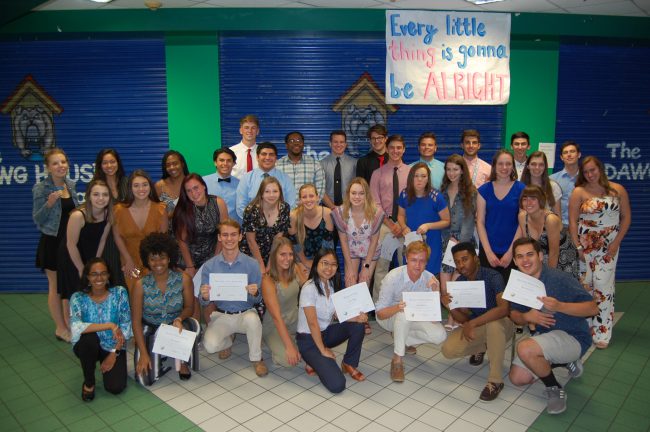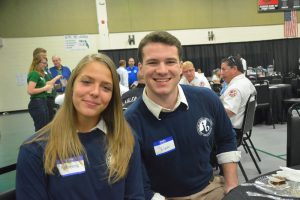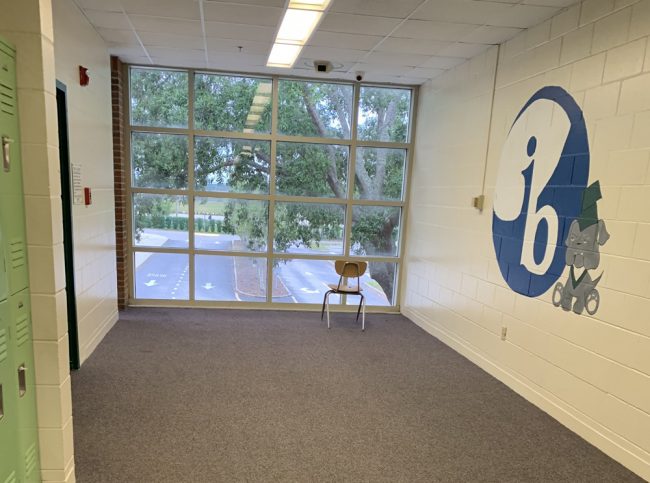
Every year, Flagler Palm Coast High School’s IB class shows the power of the International Baccalaureate program as a passport to some of the nation’s best colleges and universities. The celebrations each spring are not unusual. But this year they were for the sheer number of schools that accepted the 45 students who make up the Class of 2019, each of whom usually applies to half a dozen schools or more.
Stanford University accepted one. Duke, Penn State, Vassar, Northwestern, UCLA and Purdue each accepted one. Boston University, Georgia Tech and Wake Forest each accepted two. The University of North Carolina at Chapel Hill and New York University each accepted three. The University of Virginia accepted six. And of course Florida’s universities accepted their usual larger numbers: 27 at the University of Florida, 24 at Florida State, 12 at Stetson, five at Embry-Riddle Aeronautical University, and many more. Students were also wait-listed at Amherst, Dartmouth, Duke, Fordham, NYU, Rice, Harvard and Vanderbilt, among others.
In short, 45 students received 176 acceptance letters from 60 colleges and universities, and 11 of them were additionally wait-listed by eight schools, a remarkable achievement in a year not rarely disrupted by a series of incidents and anxieties that had nothing to do with academics.
“The kids make it happen,” Superintendent Jim tager said. “The bottom line is in our IB, teachers I feel like are very motivating. What’s happening now, across the district we’ve looked at graduation a lot and with our students that are our highest performers, we’re really celebrating where they go. So if you walk in the cafeteria at Matanzas now you’ll see pennants of all the schools where the kids are going to. At FPC you’ll see the counselors are posting all the places outside their offices where the kids are going. So we’re promoting where they’re going. I’ve got to tell you, for my second year, I’m shocked this year compare to last, the schools they’re getting into. Crazy, right?”
Oh, the Places You'll Go:
FPC's IB Class of 2019
| College or University | Number of Acceptances |
|---|---|
| Alvernia College | 1 |
| Arizona State University | 1 |
| Auburn University | 1 |
| Baylor University | 1 |
| Berry College | 1 |
| Boston University | 1 |
| Brewton Parker College | 1 |
| Capital University | 1 |
| Clemson University | 2 |
| College of Mount Saint Vincent | 1 |
| Duke University | 1 |
| Embry-Riddle Aeronautical University | 5 |
| Flagler College | 3 |
| Florida Atlantic University | 2 |
| Florida Institute of Technology | 1 |
| Florida International University | 2 |
| Florida Southern College | 1 |
| Florida State University | 24 |
| Fordham University at Lincoln Center | 1 |
| George Washington University | 2 |
| Georgia Tech | 2 |
| Jacksonville University | 1 |
| Lehigh University | 1 |
| Liberty University | 1 |
| Middlebury College | 2 |
| New World School of the Arts College | 1 |
| New York University | 3 |
| North Carolina State University | 1 |
| Northeastern University | 1 |
| Northwestern University | 1 |
| Nova Southeastern Ft. Lauderdale | 2 |
| Ohio State University | 1 |
| Oklahoma State University | 1 |
| Pace University | 1 |
| Penn State University | 1 |
| Purdue University | 1 |
| Rollins College | 1 |
| Stanford University | 1 |
| Stetson College | 12 |
| UCLA | 1 |
| United States Air Force Academy | 1 |
| United States Military Academy | 1 |
| University of Central Florida | 10 |
| University of Central Missouri | 1 |
| University of Florida | 27 |
| University of Kentucky | 1 |
| University of Miami | 4 |
| University of North Carolina at Chapel Hill | 3 |
| University of North Dakota | 1 |
| University of North Florida | 9 |
| University of San Francisco | 1 |
| University of South Florida | 13 |
| University of Tennessee | 1 |
| University of Virginia | 6 |
| University of Washington | 1 |
| Vassar College | 1 |
| Wake Forest University | 1 |
| Wellesley College | 1 |
| Western Michigan University | 1 |
| Wingate University | 1 |
| Amherst College | 1 |
| Case Western University | 1 |
| Dartmouth College | 1 |
| Davidson College | 1 |
| Duke University | 1 |
| Emory University | 2 |
| Fordham University | 2 |
| Georgia Tech | 2 |
| Harvard | 1 |
| New York University | 2 |
| Northeastern University | 3 |
| Purdue | 2 |
| Rice University | 1 |
| University of Central Florida | 6 |
| University of Chicago | 2 |
| University of North Carolina at Chapel Hill | 1 |
| University of Virginia | 2 |
| Vanderbilt University | 2 |
“A very impressive list, yes,” says Roger Tangney, who heads FPC’s IB program. “I think perhaps part of this is, previous classes have begun to branch outside the state of Florida–not to besmirch the reputation of the universities in Florida,” he said. Those students then typically return to FPC and describe their experiences to younger IB candidates. It’s had its impact, encouraging them to apply more broadly–and get in. “And financially quite frankly, a good deal of our kids going out of state have gotten very attractive financial aid packages.”
Most would need to: tuition alone at schools such as Stanford, Duke, NYU and Boston University is around $50,000 a year, $34,000 at UNC and $45,000 at the University of Virginia for out of state students, $32,000 at Georgia Tech, and so on. In comparison, it’s a mere $6,400 at the University of Florida or at Florida State, and that’s mostly covered by Bright Futures scholarships that IB students typically and easily qualify for.
Tager refers to the IB program as one of the district’s flagships–the series of programs in every school that channel students through particular career paths in less traditional, more workplace-oriented instruction. The IB is the antithesis of a careerist curriculum, its focus being the formation of global citizens who can fit in anywhere, through very rigorous instruction, and whose first goal is a good college or university. In that regard, the program is as successful as they come, even (or especially) when seen as a flagship.
Its students describe its purposes and benefits best.
“I wanted to be in IB because I wanted to academically challenge myself and it seemed more fulfilling than full AP course loads,” says senior Olivia Hale. “When you’re a part of the IB program, you’re part of a group of people going through the program with you, and since it’s a whole curriculum rather than picking and choosing courses, you have to challenge yourself some in the courses you consider yourself weaker at (for me, that’s history). Looking back on four years being part of the IB program, I’m glad I was a part of such a close-knit group of people who want to succeed just as much as I do.”
Hale got into every single school she applied to: Stetson, UF, NYU, the University of Kentucky, the University of Virginia, and Duke. She elected to go to Virginia (and, according to Warren Sanson, the math teacher, influenced other students into doing so as well.) She’ll be on a pre-med track, double-majoring in chemistry and music, with a view on surgery and emergency medicine.
Hale was well aware of her class’ unusual success. “I think we were all bought into the idea of succeeding together, and we all had a positive mindset towards doing well,” she said. “In some high school groups the focus might be more on being popular or looking good, but I feel like for us we always prioritized academically thriving. We also seem more close-knit than past IB classes, and I think that helped us all succeed as a group. We also have amazing teachers that will always talk to us when we need to blow off steam and give us any resources we need if we just ask, and I think we made good use of that.”
Tangney this year ensured that the IB program was physically allowed to operate as a school within a school, in its own wing where students and faculty interact on a daily basis, even faculty not teaching particular students. That’s helped build a sense of cohesion and purpose, Tangney says, though he wants to increase interaction between students in the higher grades and 9th and 10th grade students in pre-IB.
The Class of 2019 started four years ago with 54 students. A class typically sheds a few along the way, as did this one. The 9th grade class that started pre-IB this year had 74 students, bringing the total student enrollment in the IB and pre-IB program to 216.
In some families, a sibling making it through the program can be an inspiring factor, as it was to some extent for Julia Hok, whose sister made it through IB and is attending UF right now. “The results that IB promises in terms of college preparation and rigor, I really wanted to do that because I just felt I wanted to be challenged,” Hok said. She applied to several schools, was hoping to get into the University of Pennsylvania, was rejected–but got into Stanford. “I had no idea that Stan was going to accept me,” she said.
In school she was involved in the Flagler Youth Orchestra as a violinist and Community Problem Solvers, through which she developed a resource program for low-income children and their parents at Bunnell’s Carver Gym. “I have a lot of experience now in terms of teamwork and leadership and communications, even with adults, which I had never considered before,” Hok says. She’s exploring engineering paths–mechanical, civil, environmental: “I have a lot of passion when it comes to environmental sustainability.”
Hok speaks of her class’ success in terms of work ethic: her generation was at the outer edge of the latest technology revolution. It did not grow up, in its early years, with iPhones and iPads in its hands. “We had a lot more opportunity to become aware of certain things,” Hok says, not meaning to talk down technology: it has its place, but shouldn’t be all-absorbing. “We are a pretty good group being aware of our surroundings and having our own opinions and being aware of how our opinions affect others. That’s something the newer generation might have difficulties with, especially in the political climate right now.”
Senior Liam Dineen, like Hok, had seen IB’s successes through his siblings. “I’m actually a third sibling that’s gone through the IB program, so I knew going into high school that I was already going to do it,” he said. “It’s been fundamental in helping me develop myself to become a college student. A lot of our classes focus very heavily on critical thinking and the practical worldwide application of skills. That’s something that the IB really has a strength in, how we can apply our skills to a global perspective.”
Dineen applied in state to Florida State, UF, the University of South Florida and Miami, and was accepted to all. Out of state he was accepted to Purdue, the Air Force Academy and West Point. He was between Miami and the Air Force Academy when he was interviewed, with a focus on aerospace engineering. He didn’t apply to Embry Riddle because he said he needed to be “at least three-ish hours away. I need a little independence.”
There were of course times when he wished he wasn’t in the program because of the program’s intensity and stresses. “I thank every day looking at my friends and the relationships that I made that I stayed in to the end. I can’t imagine my high school experience without IB,” he says.
Sanson, the long-time math teacher whose storied voice every IB students has heard even when not in his class, has seen every IB class some and go since the program’s inception a decade and a half ago. He doesn’t romanticize anything, preferring the straight, to-the-point approach: yes, this was a very good year for IB’s college-entrance, he says, but “the class of 2019 is kind of split,” he said. “We kind of had a very high level, a good amount that were very strong and high level and had a very goal oriented, ambitious and so forth and so on.” On the other hand, there was also a group of students who were just hanging on. He also noticed that it may have been the most ethnically diverse IB class yet.

“IB, unlike AP or Ace,” Kouzina said (Ace is the advanced program also known as Cambridge at Matanzas), “it’s very writing based, so we’re writing papers back to back whether they be research papers o they just be essay based. A lot of our classes are presentation based, so we take the knowledge that we learned from the textbook or from a lecture and we create it into a presentation to teach our students or to teach other students. Just these little things have not only strengthened my communications skills, it’s almost strengthened my confidence, it’s helped me find a voice that to find a voice that I may not have had. Theory of Knowledge is a course that all IB students had to take, and that really questioned my thinking, it encouraged me to look at different perspectives, something that a lot of people may not be able to do, try to eliminate personal bias, really focus on–should I be using my reason, should I be using my emotion, just all these characteristics that make us human.”
The running theme for all successful IB students is inescapable: a cohesiveness that challenges them in every course, as if compelling them to be better. “Being in an environment surrounded by this drive, this dedication, has pushed me to step out of my comfort zone,” Kouzina said. “My teachers have been not just teachers, they’ve been mentors, they’ve been friends, the shoulder to cry on, the mom, the dad, whatever I may need. The supporting environment that’s created has given me the opportunities to take part in Leadership Flagler, to tutor at the Government Service Building, to go to Coastal Cloud.”
IB’s results are all in that list of college and university acceptances.
![]()





























Ap student says
Ib is overrated #ap gang
Jim Wingo says
IB is certainly not for the under achievers.